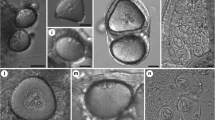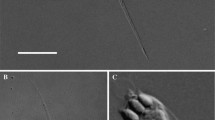Abstract
Actinosporean infection of oligochaetes living in the mud of a commercial gibel carp pond with myxosporean disease was studied. Six actinospore types were detected exclusively from the oligochaete Branchiura sowerbyi Beddard with very high prevalence (18%). Five out of the six types were identified as the same actinosporeans described in previous reports, the sixth actinosporean was identified as a new Neoactinomyxum type and described here based on morphological and molecular characterisation. Spore body of the actinospore was globular, much smaller than caudal processes. Three caudal processes were disc-like in apical view, hemispherical in side view, closer together and encircling the spore body. The number of sporoplasm cells was detected as eight in one specimen. The new actinosporean markedly differed from other Neoactinomyxum types in literature having much bigger caudal processes. DNA sequence analyses further confirmed the morphological identification, and revealed the actinosporean described here (KU641392) possessed less than 94% sequence similarity with myxozoans available in the GenBank database.


Similar content being viewed by others
References
Borhamuddin, M. H., Cech, G., Molnár, K., Nemeth, S., & Székely, C. (2014). Description of raabeia, synactinomyxon and neoactinomyxum developing stages of myxosporeans (Myxozoa) infecting Isochaetides michaelsei Lastočkin (Tubificidae) in Lake Balaton and Kis-Balaton Water Reservoir, Hungary. Systematic Parasitology, 88, 245–259.
Chang, E. S., Neuhof, M., Rubinstein, N. D., Diamant, A., Philippe, H., Huchon, D., & Cartwright, P. (2015). Genomic insights into the evolutionary origin of Myxozoa within Cnidaria. PNAS, 112, 14912–14917.
Chen, Q. L., & Ma, C. L. (Eds) (1998). Fauna Sinica. Invertebrata, Vol 15. Myxozoa, Myxosporea. Science Press, Beijing.
El-Mansy, A., Székely, C., & Molnár, K. (1998a). Studies on the occurrence of actinosporean stages of fish myxosporeans in a Lake Balaton, Hungary, with the description of Triactinomyxon, Raabeia, Aurantiactinomyxon types. Acta Veterinaria Hungarica, 46, 437–450.
El-Mansy, A., Székely, C., & Molnár, K. (1998b). Studies on the occurrence of actinosporean stages of fish myxosporeans in a fish farm of Hungary, with the description of Triactinomyxon, Raabeia, Aurantiactinomyxon and Neoactinomyxon types. Acta Veterinaria Hungarica, 46, 259–284.
Eszterbauer, E., Atkinson, S., Diamant, A., Morris, D., EI-Matbouli, M., & Hartikainen, H. (2015). Myxozoan life cycles: practical approaches and insights. In: Okamura, B., Gruhl, A. & Bartholomew, J. (Eds) Myxozoan evolution, ecology and development. Switzerland: Springer International Publishing.
Eszterbauer, E., Marton, S., Racz, Z. O., Letenyei, M., & Molnár, K. (2006). Morphological and genetic differences among actinosporean stages of fish-parasitic myxosporeans (Myxozoa): difficulties of species identification. Systematic Parasitology, 65, 97–114.
Fiala, I. (2006). The phylogeny of Myxosporea (Myxozoa) based on small subunit ribosomal RNA gene analysis. International Journal for Parasitology, 36, 1521–1534.
Holzer, A. S., Sommerville, C., & Wootten, R. (2006). Molecular identity, phylogeny and life cycle of Chloromyxum schurovi Shul’man & Ieshko 2003. Parasitology Research, 99, 90–96.
Kallert, D. M., Grabner, D. S., Yokoyama, H., EI-Matbouli, M., & Eszterbauer, E. (2015). Transmission of myxozoans to vertebrate hosts. In: Okamura, B., Gruhl, A. & Bartholomew, J. (Eds) Myxozoan evolution, ecology and development. Switzerland: Springer International Publishing.
Lom, J., & Dyková, I. (2006). Myxozoan genera: definition and notes on taxonomy, life-cycle terminology and pathogenic species. Folia Parasitologica, 53, 1–36.
Lom, J., McGeorge, J., Feist, S. W., Morris, D., & Adams, A. (1997). Guidelines for the uniform characterization of the actinosporean stages of parasites of the phylum Myxozoa. Diseases of Aquatic Organisms, 30, 1–9.
Marcucci, C., Caffara, M., & Goretti, E. (2009). Occurrence of actinosporean stages (Myxozoa) in the Nera River system (Umbria, central Italy). Parasitology Research, 105, 1517–1530.
Marquès, A. (1984). Contribution à la connaissance des Actinomyxidies: ultrastructure, cycle biologique, systématique. PhD Thesis, Université de Sciencs et Techniques de Languedoc, Montpellier, France, 218 pp.
Negredo, C., & Mulcahy, M. F. (2001). Actinosporean infections in oligochaetes in a river system in southwest Ireland with descriptions of three new forms. Diseases of Aquatic Organisms, 46, 67–77.
Okamura, B., Gruhl, A., & Reft, A. J. (2015). Cnidarian origins of the Myxozoa. In: Okamura, B., Gruhl, A. & Bartholomew J. (Eds) Myxozoan evolution, ecology and development. Switzerland: Springer International Publishing.
Özer, A., Wootten, R., & Shinn, A.P. (2002). Survey of actinosporean types (Myxozoa) belonging to seven collective groups found in a freshwater salmon farm in Northern Scotland. Folia Parasitologica, 49, 189–210.
Rangel, L. F., Rocha, S., Castro, R., Severino, R., Casal, G., Azevedo, C., Cavaleiro, F., & Santos, M. (2015). The life cycle of Ortholinea auratae (Myxozoa: Ortholineidae) involves an actinospore of the triactinomyxon morphotype infecting a marine oligochaete. Parasitology Research, 114, 2671–2678.
Ronquist, F., & Huelsenbeck, J. P. (2003). MrBayes 3: Bayesian phylogenetic inference under mixed models. Bioinformatics, 19, 1572–1574.
Sarker, S., Kallert, D. M., Hedrick, R. P., & El-Matbouli, M. (2015). Whirling disease revisited: pathogenesis, parasite biology and disease intervention. Diseases of Aquatic Organisms, 114, 155–175.
Székely, C., Borhamuddin, M. H., Cech, G., Kelemen, O., & Molnár, K. (2014). Life cycles of three Myxobolus spp. from cyprinid fishes of Lake Balaton, Hungary involve triactinomyxon-type actinospores. Parasitology Research, 113(8), 2817–2853.
Székely, C., Urawa, S., & Yokoyam, H. (2002). Occurrence of actinosporean stages of myxosporeans in an inflow brook of a salmon hatchery in the Mena River System, Hokkaido, Japan. Diseases of Aquatic Organisms, 49, 153–160.
Tamura, K., Stecher, G., Peterson, D., Filipski, A., & Kumar, S. (2013). MEGA6: Molecular Evolutionary Genetics Analysis version 6.0. Molecular Biology and Evolution, 30, 2725–2729.
Wolf, K., & Markiw, M. E. (1984). Biology contravenes taxonomy in the Myxozoa: new discoveries show alternation of invertebrate and vertebrate hosts. Science, 225, 1449–1452.
Xi, B. W., Li, P., Chen, K., Zhang, J. Y., & Xie, J. (2016). The life cycle of Thelohanellus wuhanensis from Carassius auratus involves an Aurantiactinomyxon-type actinospore. Journal of Fisheries of China, 40(4), 657–664.
Xi, B. W., Zhou, Z. G., Xie, J., Pang, L. K., Yang, Y. L., & Ge, X. P. (2015). Morphological and molecular characterization of actinosporeans infecting oligochaete Branchiura sowerbyi from Chinese carp ponds. Diseases of Aquatic Organisms, 114(3), 217–228.
Xi, B. W., Xie, J., Zhou, Q. L., Pan, L. K., & Ge, X. P. (2011). Mass mortality of pond-reared Carassius gibelio (Bloch) caused by Myxobolus ampullicapsulatusin in China. Diseases of Aquatic Organisms, 93, 257–260.
Xi, B. W., Zhang, J. Y., Xie, J., Pan, L. K., Xu, P., & Ge, X. P. (2013). Three actinosporean types (Myxozoa) from the oligochaete Branchiura sowerbyi in China. Parasitology Research, 112, 1575–1582.
Xiao, C., & Desser, S. S. (1998). Actinosporean stages of myxozoan parasites of oligochaetes from Lake Sasajewun, Algonquin Park, Ontario: New forms of echinactinomyxon, neoactinomyxum, aurantiactinomyxon, guyenotia, synactinomyxon and antonactinomyxon. Journal of Parasitology, 84, 1010–1019.
Yokoyama, H., Ogawa, K., & Wakabayashi, H. (1993). Involvement of Branchiura sowerbyi (Oligochaeta: Annelida) in the transmission of Hoferellus carassii (Myxosporea: Myxozoa), the causative agent of kidney enlargement disease (KED) of goldfish Carassius auratus. Fish Pathology, 28, 135–139.
Yokoyama, H., Grabner, D., & Shirakashi, S. (2012). Transmission biology of the Myxozoa. In: Carvalho, E. (Ed.), Health and Environment in Aquaculture. In Tech (available from: http://cdn.intechopen.com/pdfs/35136.pdf ).
Zhang, J. Y., Yokoyama, H., Wang, J. G., Li, A. H., Gong, X. N., Ryu-Hasegawa, A., Iwashita, M., & Ogawa, K. (2010). Utilization of tissue habitats by Myxobolus wulii Landsberg & Lom, 1991 in different carp hosts and disease resistance in allogynogenetic gibel carp: Redescription of M. wulii from China and Japan. Journal of Fish Diseases, 33, 57–68.
Funding
This research was supported by the Natural Sciences Foundation of China (No. 31302222), the earmarked fund for China Agriculture Research System (CARS-46), Jiangsu Fishery Project (D2015-13).
Author information
Authors and Affiliations
Corresponding authors
Ethics declarations
Conflict of interest
The authors declare that they have no conflict of interest.
Ethical approval
All applicable institutional, national and international guidelines for the care and use of animals were followed.
Rights and permissions
About this article
Cite this article
Xi, B.W., Li, P., Liu, Q.C. et al. Description of a new Neoactinomyxum type actinosporean from the oligochaete Branchiura sowerbyi Beddard. Syst Parasitol 94, 73–80 (2017). https://doi.org/10.1007/s11230-016-9677-1
Received:
Accepted:
Published:
Issue Date:
DOI: https://doi.org/10.1007/s11230-016-9677-1




